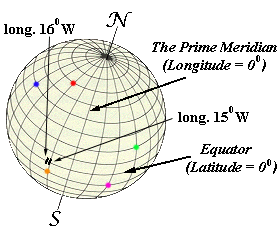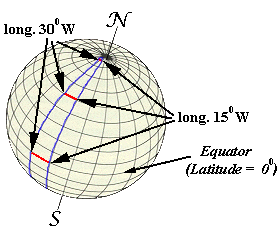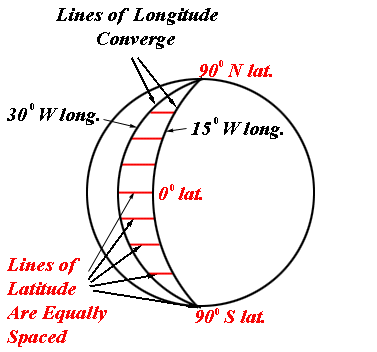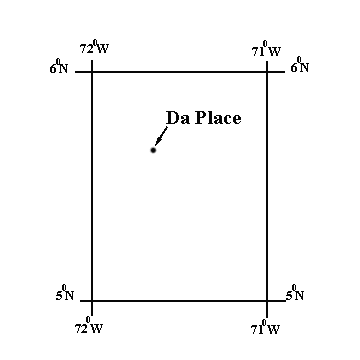
"Now let's see if you can do it, Lou! I've labeled the equator and the prime meridian. Give me the latitude and longitude of the other four colored dots! Go take the quiz!"

 | "OK! If we put both the latitude lines and the longitude lines together on the sphere, what've we got? A GRID! Now we can locate places by giving their latitude and longitude. For example, the latitude of the blue dot is 40° N, and its longitude is 60° W. (DON'T FORGET, I've only shown latitudes at 10 degree intervals and longtitude at 15 degree intervals!)" "Now let's see if you can do it, Lou! I've labeled the equator and the prime meridian. Give me the latitude and longitude of the other four colored dots! Go take the quiz!" |  |
 LINK TO QUIZ LINK TO QUIZ |
 | "So, now I'm OK with latitude and longitude, right?!" |
 | "Not quite, Lou! You've got to focus in a bit more! Tell me, how far is it in miles along the equator between two degrees of longitude, say from 15° W to 16° W?" |  |
 | "I can answer that! I seem to remember that the circumference of the earth along the equator is roughly 24,901.92 miles (heh heh!). Well, there's 360 degrees in a circle, so if we divide 24,901.92 miles by 360 degrees, we get 69.172 miles per degree! How's that! And furthermore, the distance between two lines of latitude, from 0 degrees to 1 degree north, is also 69.2 miles - because it's also 1/360th of the circumference of the earth!" " |  |
 | "You take my breath away, Lou! But what happens to the distance between lines of longitude as you go north or south away from the equator?!" |
 | "Let's look at the diagram! I can see that the lines of longitude get closer and closer together towards the poles! At the equator, the distance between 15 and 30 degrees W longitude is quite a lot! But as you follow those two longitude lines towards the poles, the distance between them shrinks down to zero! All the lines of longitude actually meet at the poles! So really, 'longitude' has no meaning when you're at the poles! I don't think I'm gonna go to the poles! I'd be nowhere! And everywhere!" |  |
 | "Don't be afraid, Lou! At least latitude still has meaning, even at the poles! Notice that the distance between lines of latitude remains the same!" |  |
 | "But what did you mean about 'needing to focus a bit more?!" |
 | "Well, suppose I told you the location of a place was 5 degrees N latitude and 71 degrees W longitude. Then you'd know where it was exactly. But suppose I told you its latitude was between 5 and 6 degrees N and its longitude was between 71 and 72 degrees W. Well, since degrees of latitude are about 69 miles apart, and degrees of longitude near the equator are maybe 60 miles or so apart, you wouldn't know very exactly where the place was located, would you!" |  |
 | "So what would you suggest?!" |
 | "I'd suggest 'minutes' and 'seconds'!" |
 | "Take your TIME, Lulu, you're confusing me!" |
 | "Not minutes and seconds of TIME, Lou! You need to remember your units of... Angular Measurement! Go to the Toolbox Menu! Then select Angular Measurement!" |
 LINK TO ANGULAR MEASUREMENT LINK TO ANGULAR MEASUREMENT |
 | "Great job, Lou! You've really measured up! But one more thing to wrap it up! Let's talk again about distance in miles! As you said, the greatest distance there can be between one degree and the next is about 69 miles! So, roughly speaking, what's the greatest distance there can be between one minute and the next? And between one second and the next?" |
| "Roughly speaking!!?! How subjective can you get, Lulu?! If one degree is 69 miles, and one degree = 60 minutes, then one minute is one-sixtieth of 69 miles! I'd say that's roughly one mile! Or would you want me to say 1.15 miles?" "And if one minute is roughly 1 mile, and there are 60 seconds in one minute, then one second is roughly one sixtieth of one mile, which is what? There are 5280 feet in a mile, so I guess I could call that roughly 6000 feet! So one sixtieth of 6000 feet is roughly 100 feet! I really don't know what you want, Lulu!" |  |
 | "You're talking my language, Lou! Roughly can be anything you want! And what you want seems OK by me!" "At any rate, as you can see, if you give latitude and longitude right down to the second, that's really pretty accurate! To within less than 100 feet! No problem finding things!" |
© 2000
David J. Leveson